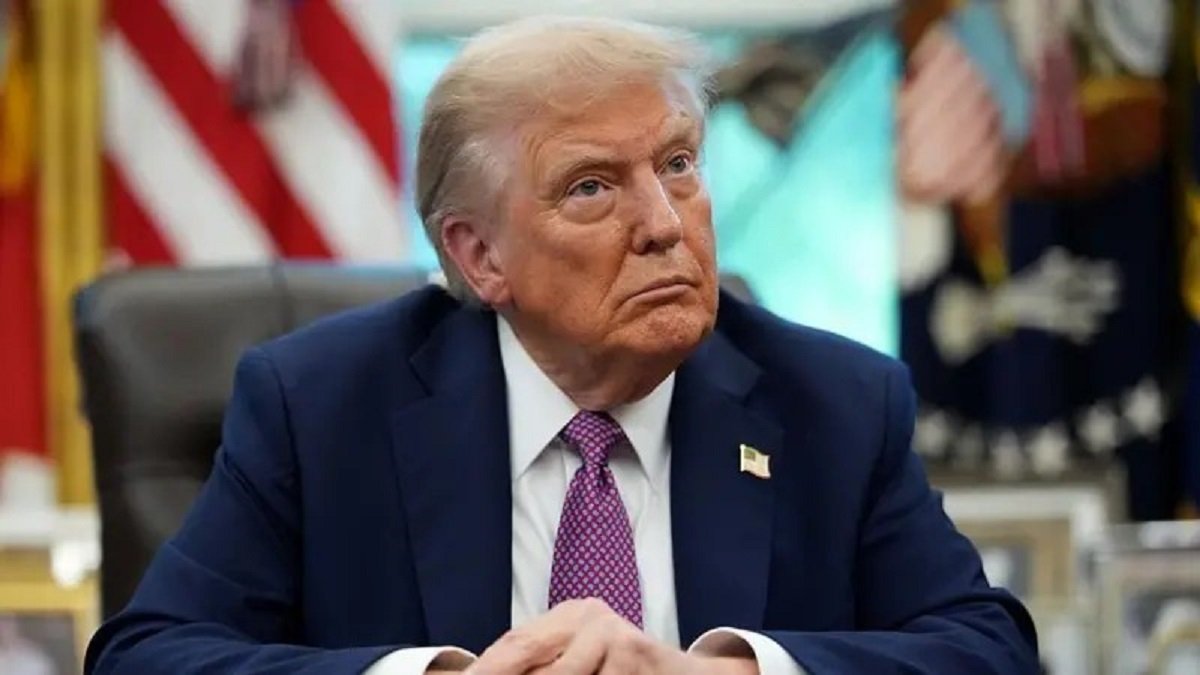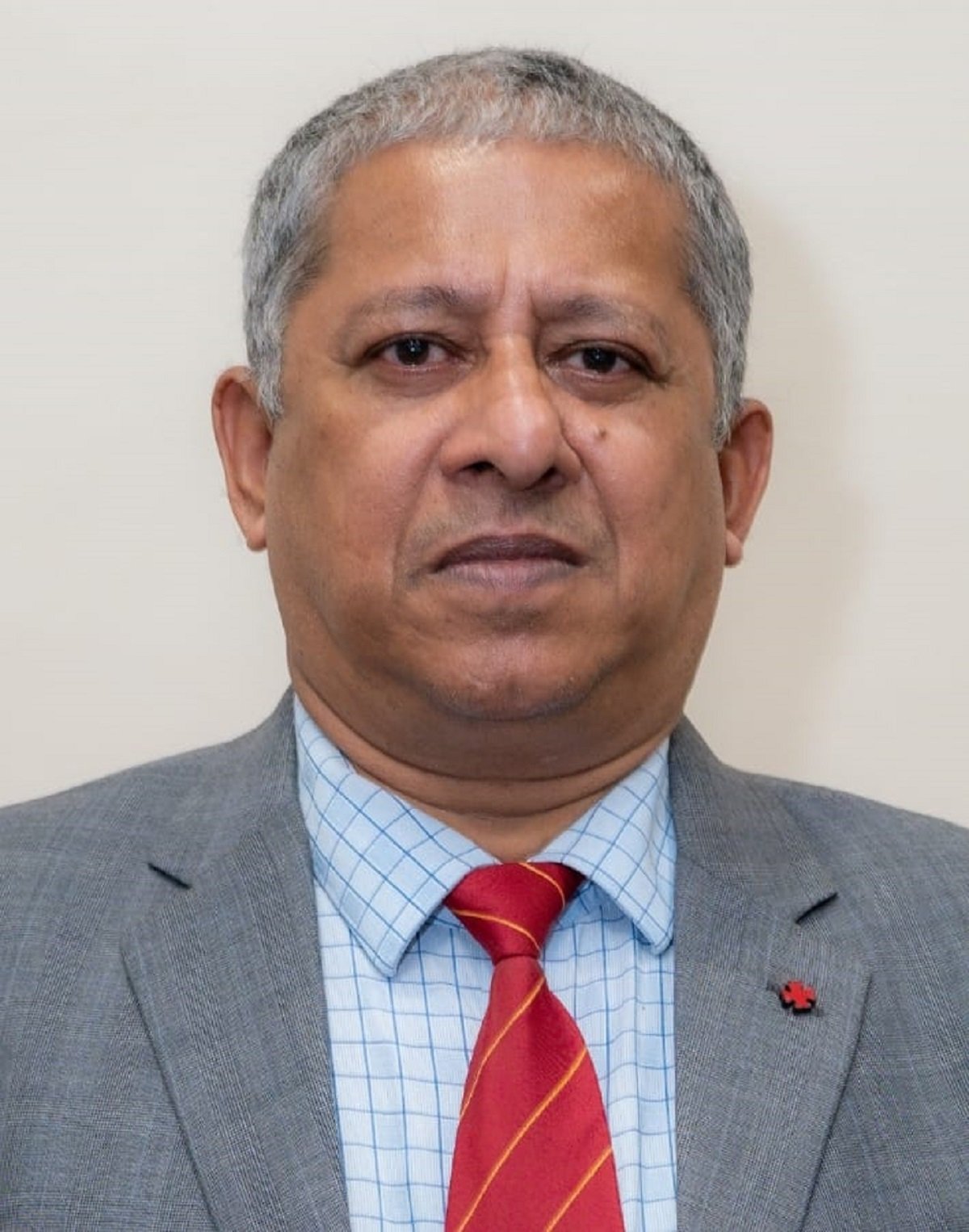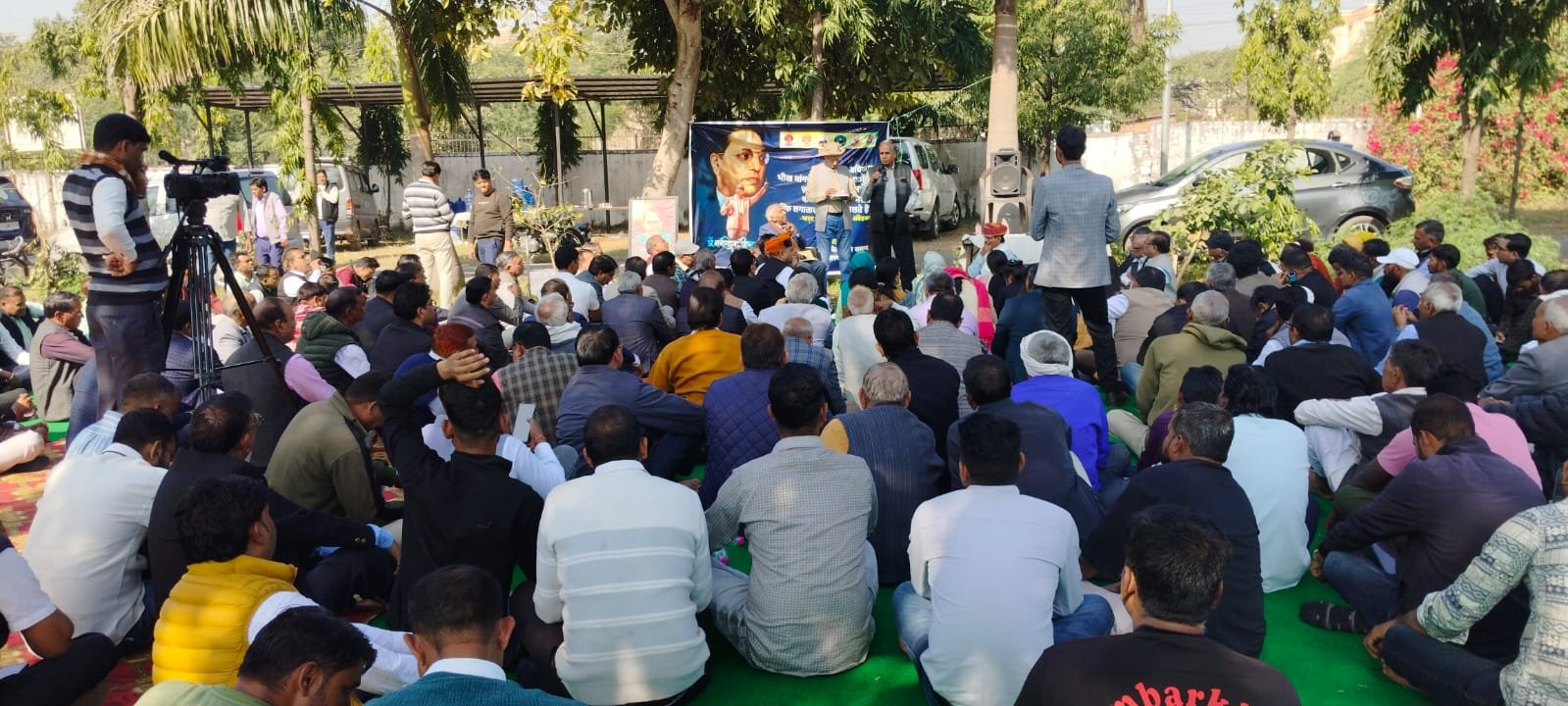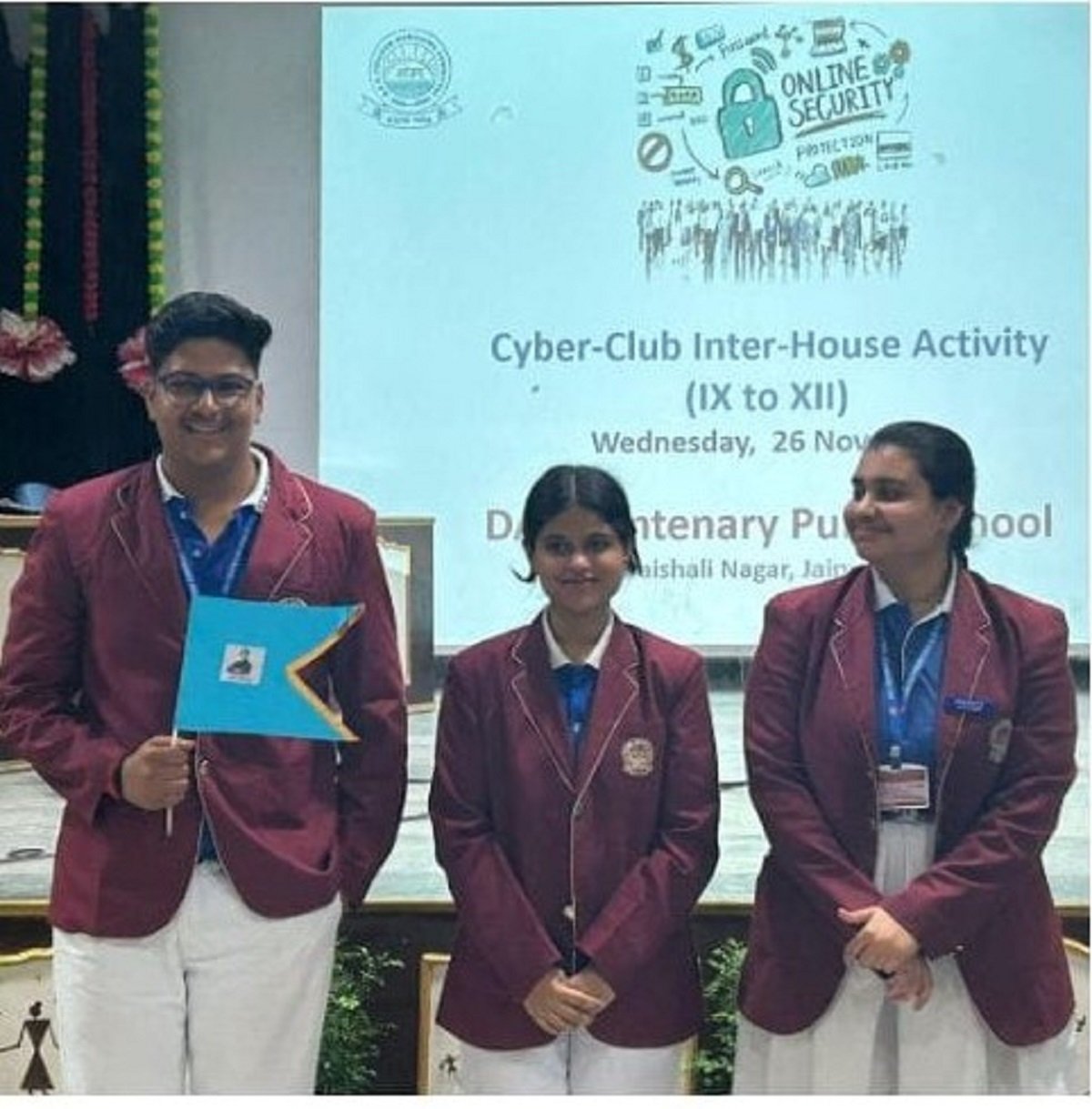Breaking News
100% tariffs on India and China” became Trump’s bold strategy to pressure Putin-

- “We’re ready to go, ready to go right now, but we’re only going to do this if our European partners step up with us,” a U.S. official conveyed.
- The FT and Reuters both reported these proposals with caution, noting the serious implications and the need for EU cooperation.
- He confirmed that trade talks with India are ongoing, with hopes for a smooth resolution.
- On social media, Trump said he plans a call with Prime Minister Narendra Modi soon. Modi, in turn, referred to India and the U.S. as “deep friends and natural partners,” and expressed optimism for the trade dialogue’s future.
- For Global Trade: Implementing 100% tariffs on India and China could trigger serious retaliation, disrupting supply chains—especially in tech, pharmaceuticals, and energy sectors.
- For Energy Markets: Targeting nations that import Russian oil could create energy shocks, especially if alternate buyers appear.
- For Geopolitics: The proposal marks a dramatic shift toward punitive trade measures as a tool of geopolitical strategy, raising questions about the role of economic coercion in diplomacy.
Contents
US,Sep.10,2025:During a high-stakes conference call with EU sanctions envoy David O’Sullivan, Trump proposed a coordinated move: the EU should impose 100% tariffs on India and China–
100% tariffs on India and China
The 100% tariffs on India and China proposal sparks alarm and intrigue. In a forceful plea to the European Union, U.S. President Donald Trump urged up to 100% tariffs on goods from India and China, marking a striking escalation in trade pressure aimed at discouraging access to Russian oil. This strategy is part of a broader effort to strangle Russia’s financial inflows amid its escalating aggression in Ukraine.
War Pressure and Oil Revenue Disruption
China and India remain two of the largest buyers of Russian oil—key revenue sources that fuel Moscow’s military campaigns. By targeting them with steep tariffs, Trump seeks to choke off funds feeding the Kremlin’s war machine.
Trump Urges EU to Apply 100% Tariffs on India and China
During a high-stakes conference call with EU sanctions envoy David O’Sullivan, Trump proposed a coordinated move: the EU should impose 100% tariffs on India and China, and the U.S. would mirror those tariffs.
Trade Talks with India Continue
Despite the tough stance, Trump also signaled warmer diplomacy with New Delhi:
EU Caution, India’s Diplomatic Tone
EU Response
EU officials appear cautious about implementing such extreme tariffs. While recognizing the strategic push to undercut Russian resources, they are wary of collateral damage to trade ties with China and India.
India’s Diplomacy
India maintains optimism in its relationship with the U.S. Modi’s response emphasized partnership, reflecting a balanced approach amid escalating economic tensions.
Global Trade, Energy Flows, and Geopolitical Risks
With the 100% tariffs on India and China proposal, Trump delivers both a tough economic ultimatum and a paradoxical embrace of diplomacy. The U.S. hopes to squeeze Putin’s resources while still nurturing ties with key partners. The outcome hinges on whether the EU will fall in line—and what global ripple effects will follow.
Breaking News
Jain Education Presentation Program at Subodh Public School Inspires Students and Community-

Contents
Jaipur,Dec.12,2025:Jain Education Presentation Program took centre stage at Subodh Public School, one of Jaipur’s leading CBSE-affiliated schools founded under the Shri S.S. Jain Subodh Shiksha Samiti. The institution, renowned for combining academic excellence with moral culture, hosted this event on 11th December 2025 to foster deeper awareness of Jain philosophy and values among youth.
The program was attended by an enthusiastic audience that included over 300 participating students, about 350 parents, and 50 teachers — making it an extraordinary community-wide celebration. The Jain Education Presentation Program created a meaningful platform that blended education, culture, religion, and artistic expression.

Jain Education Presentation Program
Right from the beginning of the event, the Jain Education Presentation Program emphasized core Jain values such as compassion, non-violence (Ahimsa), self-discipline, knowledge, and respect for all beings.
Purpose of the Program
The main objective was clear
- To increase awareness of Jain philosophy and values among students
- To promote moral education and cultural appreciation
- To encourage young minds to adopt and practice ethical living principles
Through this program, Subodh Public School aimed to nurture not only intellectual excellence but also emotional and spiritual growth in its students.
Student Performances That Stole the Show
The heart of the Jain Education Presentation Program was the student performances, crafted around Jain literature, values, and philosophy.
Navakar Mantra and Chanting
The event began with students reciting the Navakar Mantra, the most sacred prayer in Jainism — a profound act of devotion and meditation central to Jain belief. Their disciplined expression conveyed respect and sincerity.
Presentations on 24 Tirthankaras
Students delivered informative speeches and recitations of the names of 24 Tirthankaras, honouring the enlightened teachers in Jain tradition.
Musical and Cultural Performances
- Musical instruments accompanied several pieces, highlighting devotion and introspection.
- Bhajans (devotional songs) brought spiritual resonance and united the audience in cultural reverence.
- Dance performances based on Jain literature added aesthetic beauty and emotional impact.
Each performance was structured not just for entertainment, but to reflect core ethical teachings, making the Jain Education Presentation Program powerful and memorable for everyone present.

Significant Highlights and Guest Appearances
The event received strong support from religious leaders and educational dignitaries, elevating its reach and influence.
Chief Guests and Officials Present
Among notable attendees
- Shri S.S., Secretary of Jain Subodh Education Committee
- Mr. Sumer Singh Ji Bothra, Chief Guest
- R.C. Jain Sahab, Vice President
- Shri Alok Kumar Ji Bamb, School Convenor
- Principal Dr. Sanjay Parashar
- Shri Sunil Ji Kothari
- Nipun Ji Daga
- Mrs. Sunita Ji Daga
These influential figures brought attention to the value of cultural education and applauded the school’s commitment to integrating moral teachings into student life.
“Jain Sanskar Ki Or” by Sunita Ji Daga
One of the most notable moments of the Jain Education Presentation Program was the launch of the book “Jain Sanskar Ki Or” written by Mrs. Sunita Ji Daga.
This publication adds a significant resource to Jain educational literature and encourages readers — especially young learners — to deeply understand and practice Jain ethical principles. Books like this help broaden philosophical perspectives and enrich moral education beyond the classroom.

Why This Event Matters for Education Today
The Jain Education Presentation Program was not just a school event — it was a milestone in value-based education.
Building Emotional and Moral Intelligence
Teaching children to think deeply about compassion, self-discipline, and community care contributes to emotional intelligence, which is increasingly recognized as essential in modern education. Education experts agree that fostering moral understanding alongside academic instruction builds better citizens.
Promoting Cultural Respect
In today’s multicultural world, cultural education helps students communicate with respect, embrace diversity, and uphold tradition. Tying ancient Jain values with contemporary schooling enables students to connect heritage with global citizenship.
Community and Cultural Impact
With over 350 parents in attendance, the Jain Education Presentation Program influenced not just students but the entire family community.
Parents appreciated the school’s efforts to blend academic rigour with deep moral understanding. Teachers also expressed pride in student participation and noted how such events strengthen community bonds, encourage family involvement, and help students practice leadership and public speaking.
The Jain Education Presentation Program at Subodh Public School was a clear success — a celebration that brought together students, families, educators, and religious scholars around shared values of peace and ethical living.
Events like this are essential in nurturing future generations who are not only academically proficient but also morally grounded. As schools increasingly adopt value-centric programs, it is hopeful that similar initiatives will continue influencing young minds across India’s educational landscape.
Breaking News
Jaipur Gold Silver Price Today: Get the latest 24K, 22K & 18K gold and silver rates in Jaipur —

Contents
Jaipur, Dec.11,2025:Jaipur Gold Silver Price Today is back in news headlines, as both gold and silver rates witnessed a fresh upsurge in local markets. The volatility, which has been a hallmark of recent weeks, is especially relevant now — with the wedding season in full swing and many people looking to buy precious metals for jewellery or investment. Reports suggest that prices in Jaipur have again climbed, shaking off the brief slump observed just days ago.
As of today (11 December 2025), residents of Jaipur are once again scanning local jewellery shops and checking online portals before deciding to buy — largely to avoid paying more than necessary.
Why Are Gold & Silver Prices Rising Again in Jaipur
Several factors are contributing to the renewed uptick
- Global market dynamics: After the recent interest-rate cut by the Federal Reserve (Fed) in the US, precious metals have become more attractive globally, prompting demand and pushing up prices of gold and silver.
- Investor sentiment: With economic uncertainty and inflation concerns, investors tend to move toward safe-haven assets like gold and silver — particularly in India, which has strong cultural affinity for physical metals.
- Local demand surge: Jaipur — being a city renowned for jewellery craftsmanship and known as a hub for wedding jewellery — sees increased demand during the wedding season. Many people buy gold and silver to gift, invest, or add to their personal jewellery collections. That demand spike pushes rates upward locally.
- Supply and global commodity trends: International supply constraints, shifting demand, and global macroeconomic forces influence domestic bullion rates, which in turn reflect in city-level rates like Jaipur.
Because of these converging factors, Jaipur Gold Silver Price Today has registered upward movement — catching the attention of buyers and investors alike.
Current Rates in Jaipur (24K / 22K / 18K Gold + Silver)
Here is the latest snapshot of precious-metal prices in Jaipur as reported by leading price-tracker portalsMetal / Purity Rate (per gram / per kg) – Approx (as of 11 Dec 2025) 24 Carat Gold ₹ 13,035 / gram 22 Carat Gold ₹ 11,950 / gram 18 Carat Gold ₹ 9,780 / gram Silver (999) ~₹ 199.83 / gram (≈ ₹ 1,998.28 per 10 g)
Important: These rates represent the live bullion rates. Actual jewellery prices may be higher due to making charges, GST, labour cost, design complexity, and other shop-specific margins.
What This Means for Buyers, Investors and Wedding Shoppers
For Jewellery Buyers
- Timing is critical — Buying at a local peak can add unnecessary cost. With steep rise lately, some buyers may regret not checking rates a week ago.
- Check making charges & purity — Since jewellery involves craftsmanship, always ask for total cost (metal + making + taxes) and purity certificate before purchasing.
- Budget smartly — For 24K or 22K jewellery, small weight savings can reduce total spend significantly when gram-rate is high.
For Investors & Silver Buyers
- Silver is breaking records — As per recent reports, silver has soared to all-time highs, reflecting robust industrial demand and investor shift to safer assets after Fed’s rate cuts.
- Gold remains a hedge — Gold continues to be seen as a hedge against inflation and economic uncertainty, especially in markets like Jaipur where physical purchase is common.
For Wedding & Festive Shoppers
- Seasonal demand increases price — Wedding season always drives demand — and with global cues pushing bullion prices, local demand magnifies that effect. Buying early could save big.
- Consider alternatives — If prices are too high, 22K jewellery (instead of 24K) or silver items might be a more affordable choice without compromising on tradition or look.
Tips Before You Buy Gold or Silver in Jaipur
- Always check live metal rates on trusted portals or ask multiple local jewellers — don’t buy based on last-known rate.
- Compare total cost (metal + making + taxes) rather than only gram-rate.
- If buying jewellery for long-term investment, consider simpler designs (less making charge) and smaller quantities to reduce overall expenditure.
- For silver: since prices are very volatile, consider buying after dips or investing in small quantities.
- If for gifting (weddings/festivals), track market for a few days — sometimes delaying 2–3 days can save you a few hundred per gram.
Jaipur Gold Silver Price Today stands as a reminder — in the world of precious metals, timing and market awareness matter. Whether you are investing, buying jewellery for yourself, or gift shopping for weddings, keeping an eye on live rates, global market cues, and local demand trends can make a big difference.
Breaking News
Career Guidance as a Human Right should be accessible to everyone —

Contents
Bengaluru,Dec.09,2025: “Career Guidance as a Human Right” is not just a slogan — it’s a vision that recognizes the fundamental importance of informed career planning in shaping individuals’ lives and societies at large. In a world changed by rapid technological shifts, evolving job markets, and widening social inequalities, giving everyone access to high-quality career guidance is not optional — it’s essential.
Career guidance empowers individuals to understand themselves, their strengths, their values, and align them with opportunities that lead to sustained personal and professional growth. When accessible to all — regardless of background — it can help bridge the gap between potential and opportunity, turning aspirations into meaningful careers and reducing inequality in the process.
What Is Career Guidance — And Who Benefits
Definition and Goals
Career guidance refers to structured advice, counselling, and support provided to individuals to help them make informed decisions about their education, training, and career paths. According to international frameworks, its purpose is to help people: understand their strengths and interests, realistically examine labour market opportunities, adapt to changing work environments, and make decisions that reflect both personal aspirations and market demand.
Career guidance helps individuals
- develop self-awareness about abilities, weaknesses, interests, and values;
- explore a wide range of career options — not just traditional or familiar ones — including emerging fields;
- plan realistic and achievable education/career pathways, including internships, skill development, and job search strategies;
- build confidence, reduce anxiety around career decisions, and stay motivated;
- Who Needs It
- Students and young people, at the point of choosing streams, courses or higher education, when decisions can have lifelong impact.
- Early-career individuals or fresh graduates, needing guidance to align their education with market realities, prepare for job applications, and understand evolving trends.
- Adults undergoing career changes or upskilling, especially in a world where automation, globalization and sectoral shifts are common.
- Marginalized or disadvantaged groups — people from low socio-economic backgrounds, underrepresented communities, or rural areas, who often lack access to reliable career information and mentoring.
- In this way, career guidance isn’t a luxury — it’s a foundational support system that everyone should have access to, at different stages of life.
Inequality, Social Mobility and Career Guidance
The Inequality Challenge
Across the world, individuals from low socio-economic status (SES) backgrounds face disproportionate barriers when transitioning from education to work. Even if they have equivalent qualifications, lack of social and cultural capital — like access to networks, role models, or labour-market insight — often prevents them from converting potential into opportunity.
Research from OECD (2024) confirms that students from disadvantaged backgrounds engage less in career development activities than their peers, leading to social inequality and limited upward mobility.
Meanwhile, for many countries — including India — the availability of trained career counsellors is far below what is considered standard globally. For instance, a widely cited estimate suggests that India would need over 1.4 million counsellors to meet global norms, yet the actual ratio remains far lower, leaving most students without structured guidance.
How Career Guidance Can Mitigate Inequality
Implementing equitable career guidance systems — especially in schools and community centres — can significantly level the playing field
- Personalized support helps students from all backgrounds understand the full range of career options, even those they might never have considered due to social or economic barriers. This includes exposure to non-traditional or emerging fields, breaking stereotypes around “elite jobs.”
- Bridging knowledge gaps: Providing up-to-date, accurate labour-market information, required qualifications, skill demands — essential for making sound career decisions, especially for those lacking access to informal networks.
- Building social and cultural capital: Through mentoring, internships, exposure visits, job fairs, and employer engagement — which are especially effective when public employment services or schools partner with employers and community groups.
- Encouraging lifelong adaptability: As the job market evolves rapidly, career guidance equips individuals to reskill or pivot — preventing skill mismatches and unemployment traps.
By embedding career guidance into public policy and education systems — and ensuring it reaches underserved communities — societies can take a concrete step toward equal opportunity and social mobility.
Career Guidance Over the Lifespan
While guidance early in life is crucial, the reality of the modern world demands support across one’s working life.
For Adults and Career Changers
According to OECD data, many adults seek career advice later in life — for job changes, upskilling or adapting to shifting labour markets.
But ironically, those who might need it most — lower-educated adults, people in high-automation risk occupations, or rural workers — are least likely to access guidance.
Ensuring career guidance as a human right means making services accessible across age groups: supporting mid-career transitions, retraining efforts, or navigating uncertain job markets.
For Organizations and the Economy
Quality career guidance doesn’t just serve individuals — it strengthens institutions and economies. Businesses benefit from employees whose skills and aspirations are aligned with their roles; societies benefit from a workforce that is adaptable, motivated, and engaged.
Providing lifelong career guidance promotes continuous learning and flexibility — essential traits in an era of automation, globalization, and fast-changing demands.
Economic Growth, Inclusion and Purpose
Recognizing career guidance as a human right isn’t just beneficial for individuals — it carries wide societal benefits.
1. Reducing Skill Mismatch and Boosting Employment
By aligning individuals’ interests, strengths, and training with actual labour-market demands, career guidance reduces skill mismatches, lowers unemployment/underemployment, and ensures a more efficient labour supply.
This not only improves job prospects for individuals but also helps economies meet labour demand, increase productivity, and foster sustainable growth.
2. Promoting Social Equity and Mobility
When career guidance is accessible across socio-economic, gender, and geographic divides, it becomes a tool for social justice. It ensures that people from disadvantaged backgrounds have equal access to information, opportunities, mentorship and pathways — helping them rise based on merit rather than privilege.
3. Encouraging Purpose, Well-being and Stability
Beyond financial outcomes, guided career decisions can lead to greater job satisfaction, personal fulfillment, and a sense of purpose. People who work in fields aligned with their values and strengths tend to be more engaged, motivated, and mentally healthier.
This not only benefits individuals — but also helps build more stable, cohesive and hopeful societies.
How to Make Career Guidance a Right
Turning “Career Guidance as a Human Right” from ideal into reality requires coordinated action across stakeholders: governments, educational institutions, employers, and communities. Here’s a roadmap:
Embed Career Guidance in School Curricula
- Introduce structured career education and counselling as a core part of school curricula starting from secondary school (or even before).
- Ensure sufficient number of trained career counsellors per school — globally accepted ratios (e.g. counsellor to student) should guide policy
- Provide equal access across rural and urban schools, ensuring marginalized communities are included.
Invest in Continuous, Lifelong Guidance
- Extend guidance services beyond school — offer them at community centres, public employment services, and adult education platforms.
- Develop systems that allow for reskilling and career transitions, especially in sectors facing disruption or automation.
Engage Employers, Industry and Social Partners
- Encourage collaboration between schools/colleges and employers to offer internships, job-shadowing, industry talks and mentoring. This helps bridge the gap between theoretical education and real-world demands
- Maintain updated labour-market information so counselling is grounded in current and future demands — not outdated assumptions.
Prioritize Equity and Inclusion
- Pro-actively target underrepresented/marginalized groups — low-income, rural, gender minorities, migrants — to ensure they receive guidance and support.
- Design customised, culturally-sensitive guidance programmes.
Ensure Quality, Professionalism and Accountability
- Train counsellors not just in traditional career advice but also in labour-market intelligence, cultural mediation, psychological assessment, and lifelong learning strategies.
- Monitor and evaluate guidance programmes to ensure they deliver real value — increased employability, better career outcomes, social mobility.
Unlocking Futures Begins with Access
Recognizing Career Guidance as a Human Right is not just a moral imperative — it is a practical necessity in today’s rapidly changing world. It gives individuals clarity, purpose, and a fair shot at success — regardless of background. It strengthens societies by promoting equity, mobility, and economic resilience.
When career guidance is available to all — from students in remote villages to adults seeking career pivots — we unlock the immense, often untapped human potential. We pave the way for more inclusive growth, meaningful work, and real opportunity.
Prof Suvasish Mukhopadhyay
Contact no. : +91 98232 93641
Mail Id : pr**********@********il.com
Breaking News
Ambedkar Memorial Welfare Society Constitutional Crisis-

Contents
Jaipur,Dec.08,2025:Ambedkar Memorial Welfare Society Constitutional Crisis has emerged as one of the most alarming organisational conflicts in Rajasthan’s social sector in recent years. What began as a routine election year suddenly transformed into a full-scale governance challenge, raising profound questions about democracy, transparency and institutional discipline within one of the state’s most respected organisations.
The dispute intensified when allegations surfaced regarding interference in the ongoing election process, the abrupt removal of the appointed election officer, and the controversial locking of the election office. These actions triggered widespread unrest among life members, former presidents, district heads, office bearers and senior guardians of the society.
Ambedkar Memorial Welfare Society Constitutional Crisis Takes a Serious Turn
On 7 November 2025, the Jaipur premises of the Dr. Ambedkar Memorial Welfare Society witnessed an unprecedented gathering of thousands of stakeholders. The General Assembly, called on an urgent basis, met with the sole purpose of examining what members described as a “serious constitutional breakdown” within the society.
Members expressed grave concern that the constitutional processes enshrined to protect the democratic character of the institution were allegedly being overridden by arbitrary decisions of certain individuals within the current executive committee.
General Assembly Confronts Growing Disorder
Several participants highlighted the rapidly deteriorating governance environment, accusing the working committee of:
- Violating established constitutional norms
- Acting without procedural legitimacy
- Creating unhealthy precedents for election interference
- Undermining democratic values the society is built upon
The Assembly identified that the Ambedkar Memorial Welfare Society Constitutional Crisis was no longer just an internal dispute—it had escalated into an institutional emergency requiring immediate corrective action.
7 Major Resolutions Passed Unanimously
In a rare show of unity, thousands of members passed seven powerful resolutions, all unanimously
1. Immediate Reinstatement of Election Officer J.P. Vimal (Retd. IAS)
The Assembly declared the removal of Shri J.P. Vimal “illegal, unjustified and against democratic ethos.”
His reinstatement is expected to restore trust in the election process.
2. Opening of the Locked Election Office
The house demanded the immediate unlocking of the election office to ensure transparency and prevent tampering.
3. Permission for the Election Officer to Resume Duties
The Assembly resolved that J.P. Vimal and his committee must be allowed to carry out the ongoing election process without interference.
4. Immediate Cancellation of the Appointment of Chhagan Beniwal as New Election Officer
Members termed his appointment unconstitutional and improper.
5. Restoration of Respect and Authority of the Original Election Committee
To secure institutional dignity, the members called for uninterrupted functioning of the original committee.
6. Full Inquiry Into the Ajmer Membership Dispute
Over 11,630 Ajmer members were at the centre of a heated debate. The Assembly instructed that a fair and impartial inquiry be conducted under the supervision of the reinstated election officer.
7. Acceptance of Inquiry Committee Decisions as Final
The Assembly declared that the final decision of the election officer, based on the inquiry report, shall be binding upon all parties.
These resolutions were not only unanimous but also highly charged, marking a stunning turning point in the Ambedkar Memorial Welfare Society Constitutional Crisis.
Ajmer Membership Controversy
The disputed inclusion of 11,630 Ajmer district members in the electoral rolls had triggered confusion and allegations of manipulation.
To address this
- A neutral fact-finding committee will be set up
- Supervised directly by Retd. IAS J.P. Vimal
- Its final report will guide voter list corrections
- No party will be allowed to challenge the outcome
This move aims to ensure transparency and restore credibility.
Proposed Consensus Formula for Stability
Senior members of the society proposed an extraordinary compromise formula to prevent prolonged conflict
- Elect Retd. IAS Hanuman Prasad unopposed as President
- Both contesting candidates,
- Former IPS Satveer Singh
- Former IPS Dr. Ravi Prakash Mehrada,
should withdraw their nominations
Many elders praised this formula as the “best coordination-based solution” to resolve the Ambedkar Memorial Welfare Society Constitutional Crisis peacefully.
Members Raise Objections on Key Decisions
Members severely criticised recent actions of the current executive, calling them
- Unconstitutional
- Arbitrary
- Society-damaging
- Undemocratic
The objected actions included
- Illegal removal of senior office bearers
- Filing FIRs against 17 members
- Appointment of a president without following due procedure
- Removal of the established election officer
- Forceful locking of the election office
Every point of objection was followed by a formal resolution demanding corrective measures.
Security of Election Material Strengthened
Given rising tensions, the General Assembly directed that an additional security lock be placed over the existing lock on the election office.
This dual-lock system ensures:
- Safety of ballot papers
- Protection of official records
- Prevention of unauthorised access
- Assurance of tamper-proof elections
This decision was received with strong approval.
Key Signatories Supporting the Assembly’s Decisions
The landmark resolutions were approved and countersigned by senior leaders, including
- Banwari Lal Bairwa (President / Senior Vice President)
- Dayanand Sakkarwal (Treasurer)
- Dr. Bhajan Lal Rolan (Former President)
- Retd. IAS Shriram Chordia
- Retd. IAS B.L. Naval
- And thousands of attending members
Their signatures mark an institutional affirmation of the Assembly’s authority.
Why This Crisis Matters for Democratic Integrity
The Ambedkar Memorial Welfare Society Constitutional Crisis is not merely an internal organisational issue.
It raises larger questions
- How can democratic values be protected in social institutions?
- What safeguards are needed to prevent election manipulation?
- How can transparency be ensured in membership procedures?
- What corrective steps should be institutionalised to prevent future crises?
This event may shape future governance models across many social organisations in India.
The Ambedkar Memorial Welfare Society Constitutional Crisis has exposed deep fissures within one of Rajasthan’s most respected institutions. Yet, the overwhelming unity shown by thousands of members at the General Assembly signals a strong commitment to transparency, constitutional discipline, and democratic procedures.
Whether the reinstatement of the election officer and the inquiry process help restore stability will determine the society’s future direction. One thing is clear—the members are unwilling to compromise on constitutional values, and their actions today may set a powerful precedent for organisational democracy across India.
Breaking News
Nrityanjali National Festival 2025 showcased India’s classical dance brilliance with Kathak, Bharatanatyam-

Contents
Ajmer,,Dec.08,2025:The Nrityanjali National Festival 2025 stood out this year as one of Ajmer’s most culturally enriching events, radiating the power and purity of Indian classical dance. The festival successfully showcased a blend of bhaav, raag, and taal, bringing audiences closer to the emotional essence of traditional dance forms.
The festival’s central theme revolved around devotion, discipline, and artistic excellence—values deeply connected to the life and teachings of the legendary Kathak exponent Dr. Nupur Roy.


A Heartfelt Tribute to Dr. Nupur Roy
The opening moments of the Nrityanjali National Festival 2025 were deeply emotional as artists, students, and dignitaries paid homage to Late Dr. Nupur Roy on her 83rd birth anniversary.
A floral tribute before her portrait marked the beginning of the event.
Dr. Roy founded Vividha Kala Evam Sanskritik Sanstha in 1998 with the sole purpose of nurturing classical art forms among children and youth.
Her legacy continues to inspire thousands who learned Kathak under her guidance, making the festival not only a cultural event but also a celebration of her lifelong dedication to Indian classical dance.
Grand Inauguration Graced by Eminent Personalities
The Nrityanjali National Festival 2025 had a prestigious opening as several distinguished guests inaugurated the event by lighting the ceremonial lamp.
Among the dignitaries were
- Rajasthan Legislative Assembly Speaker Prof. Vasudev Devnani
- Editor-in-Chief of Dainik Navjyoti Shri Dinbandhu Chaudhary
- Swami Shivjyotishanand Maharaj of Sanyas Ashram
- Ajmer City Congress President Rajkumar Jaipal
- Kota University Vice Chancellor Shri B.P. Saraswat
- Former Vice Chancellor Prof. Naresh Dadheech
- ND Mathur from Vivekananda Global University, Jaipur
- BJP District President Shri Ramesh Soni
Their presence added prestige and recognition to the cultural significance of the festival.
Kathak, Bharatanatyam & Bollywood Classical Fusion Enthrall Audience
The Nrityanjali National Festival 2025 opened with a spiritually uplifting performance of Durga Stuti and Shiv Stuti, presented by students of Ajmer Kathak Kala Kendra under the guidance of vocalist Karuna Gaur.
The festival’s dance presentations reflected excellence in Indian classical traditions
- Kathak performances highlighted graceful spins, rhythmic footwork, and expressive storytelling.
- Bharatanatyam presentations brought alive the precision and sculpturesque beauty of the dance form.
- Bollywood-style classical fusions added a contemporary flavor while maintaining classical roots.
Audiences described the performances as “magnetic, soulful, and spiritually elevating,” setting the tone for the rest of the evening.
Students from Ajmer Schools and Colleges Illuminate the Stage
One of the major attractions of the Nrityanjali National Festival 2025 was the enthusiastic participation from various schools and colleges across Ajmer. Students presented group dances representing diverse cultural themes.
Their energetic and synchronized performances highlighted
- Youthful talent
- Cultural diversity
- Strong classical training
- Growth of performing arts in Ajmer
Parents, teachers, and audience members applauded the students’ dedication and stage confidence.
Special Performances by Renowned Artists Elevate Nrityanjali National Festival 2025
The highlight of the evening was the outstanding performance by Drishti Roy, President of Vividha Sanstha and a noted Kathak dancer.
Her soulful rendition of the Krishna Bhajan “Piya Tose Laga Jo Ye Man” left the audience spellbound.
Additionally, two accomplished dancers trained at the Delhi Kathak Kendra—
- Neha Vashistha
- Vishakha Tiwari Mishra
—presented mesmerizing Kathak recitals that showcased impeccable technique, rhythmic mastery, and expressive elegance.
Their contribution added artistic depth to the event, making it a memorable cultural showcase.

Legacy of Vividha Sanstha and Ajmer Kathak Kala Kendra
The Nrityanjali National Festival 2025 reflects the long-lasting commitment of Vividha Kala Evam Sanskritik Sanstha and Ajmer Kathak Kala Kendra, both affiliated with the Rajasthan Sangeet Natak Akademi.
Key highlights of the institution’s legacy
- Founded on 8 May 1998 by Late Dr. Nupur Roy
- Non-profitable society dedicated to art education
- Trained thousands of young girls in Kathak over 27 years
- Regularly organizes classical dance and music programs
- Provides performance platforms to emerging artists
- Promotes Indian classical music and dance among the masses
Their mission is to ensure that future generations remain rooted in India’s cultural values through classical arts.
Cultural Impact and Vision of Nrityanjali National Festival 2025
The festival played a vital role in promoting cultural awareness and artistic sensitivity among the youth. Through performances, workshops, and public events, the festival emphasized
- Importance of classical training
- Preservation of traditional dance forms
- Encouraging young artists
- Cultural bonding in the community
Such festivals help strengthen India’s cultural fabric while ensuring that classical arts continue to flourish.
Organizing Team and Vote of Thanks
The success of Nrityanjali National Festival 2025 was made possible by the dedicated team members of Vividha Sanstha, including
- K.K. Gaur
- Kiran Puri
- Govind Rotela
- Uttam Sharma
- Mahesh Balaheri
At the conclusion of the event,
Dr. Bandana Chakravarty,
President & Director Drishti Roy, and
Cultural Secretary Kalpana Kaswa
extended heartfelt gratitude to all dignitaries, dancers, parents, media representatives, and guests for their support.
Breaking News
School Level Painting Competition 2025 celebrated energy conservation through creativity-

Contents
Jaipur,Dec.08,2025:The School Level Painting Competition 2025 was designed to spark environmental consciousness through creativity. By encouraging students to express their understanding of energy efficiency through art, the competition empowered young minds to think critically about the planet’s future.
India’s dependence on clean, renewable energy has grown significantly in recent years. With increasing global concerns over climate change, initiatives like this competition help spread vital messages among future generations.
The Ministry of Power and BEE (Bureau of Energy Efficiency) have consistently worked to integrate creative programmes into national awareness campaigns. This competition stands as a leading example of how education, art, and sustainability can come together to create long-term impact.
Objectives Behind the School Level Painting Competition 2025
The primary goals of the School Level Painting Competition 2025 were
- To promote awareness about energy efficiency
- To encourage students to adopt sustainable habits
- To foster creativity through environmental themes
- To prepare young ambassadors of energy conservation
- To support the government’s national mission for a greener India
The competition highlighted the fact that small actions—switching off lights, using star-rated appliances, reducing electricity wastage—can have massive positive effects when adopted collectively.
Themes of the School Level Painting Competition 2025
Students were asked to create artwork based on two powerful, thought-provoking themes
“SAVE ENERGY, SAVE EARTH”
This universal message emphasised
- Reducing electricity consumption
- Choosing eco-friendly lifestyle habits
- Protecting natural resources
- Creating a sustainable planet for future generations
Children illustrated windmills, solar panels, green cities, and responsible behaviours that reflect a world powered by clean energy.
“BE A STAR – USE BEE STAR APPLIANCES”
This theme focused on the BEE Star Rating, which helps consumers choose energy-efficient appliances.
Students depicted
- Energy-saving refrigerators
- Star-rated ACs
- LED lighting
- Eco-conscious homes
This theme connected real-world decisions with environmental impact, showing how households can save both electricity and money.
Massive Participation in the School Level Painting Competition 2025
The scale of the competition was extraordinary
- 280 schools participated at the state-level event.
- 38,000+ students submitted paintings across categories.
- Participants were divided into:
Group A: Classes 5–7
Group B: Classes 8–10
These numbers reflect the growing interest in environmental learning among children.
Such enthusiastic participation demonstrates that young citizens are ready to take the lead in climate responsibility when given the right platform.
A Grand Venue for a Grand Cause
The State Level event was held on
24 November 2025 (Monday)
Rajasthan International Centre, Jhalana Doongri, Jaipur
10 AM – 12 Noon
The Rajasthan International Centre offered a professional, vibrant environment suited for an event of this scale. The hall was filled with colour, creativity, and meaningful artistic expression from students across the state.
Teachers, parents, coordinators, and officials from BEE were present to guide and support the young participants. The atmosphere was buzzing with excitement, inspiration, and a strong sense of purpose.
Winners Announced at the School Level Painting Competition 2025
One of the most heart-warming highlights of the School Level Painting Competition 2025 was the spectacular performance of students from DAV Centenary Public School, Jaipur.
Three young artists brought immense pride to the institution by securing top positions:
Manasvi Naruka – First Prize (Group A)
Cash Prize: ₹50,000
Her artwork beautifully captured the essence of sustainable living and responsible energy use.
Himanshi Modi – Second Prize (Group B)
Cash Prize: ₹30,000
Her painting stood out for its powerful message and artistic technique.
Kanchan Saini – Consolation Prize
Cash Prize: ₹9,500
Her artwork reflected creativity, imagination, and a strong awareness of energy conservation.
These achievements highlight the school’s excellence in nurturing creative talent and socially aware citizens.
Cash Prizes and Recognition under the School Level Painting Competition 2025
The large cash prizes offered by BEE demonstrate the government’s commitment to motivating young artists and environmental ambassadors.
Students not only gained recognition but also developed
- A deeper understanding of energy efficiency
- Confidence in their artistic abilities
- Motivation to pursue higher levels of creative excellence
Teachers and parents expressed pride as the winners received their awards with applause and encouragement.
Selection for the National Level Round in New Delhi
An exciting announcement accompanied the results
The first and second prize winners from both groups were selected to represent Rajasthan in the National Level Painting Competition, scheduled for:
14 December 2025
New Delhi
This national platform will allow students to showcase their vision among participants from all Indian states and union territories.
The journey from state-level victory to a national stage stands as an important milestone in their artistic and academic growth.
Role of Schools in Promoting Energy Awareness
The School Level Painting Competition 2025 once again proved that schools play a crucial role in
- Environmental education
- Creative expression
- Behavioural awareness
- Sustainable living habits
By encouraging participation, teachers help students transform knowledge into action.
DAV Centenary Public School’s Principal, Mr. A. K. Sharma, praised the winners and encouraged all students to continue participating in awareness-based competitions to support the nation’s sustainability mission.
Why Painting Competitions Matter in Sustainability Education
Art has the power to communicate emotions and ideas that words alone cannot express. Painting competitions play a unique role in
- Engaging students visually and creatively
- Simplifying complex issues like energy efficiency
- Encouraging independent thinking
- Spreading environmental messages through impactful visuals
Creative contests allow children to become ambassadors of sustainable living, influencing families and communities in meaningful ways.
A Bright and Sustainable Future Begins with Young Minds
The School Level Painting Competition 2025 was a resounding success, uniting thousands of young voices under the powerful message of energy conservation. With themes that combined creativity and environmental awareness, this initiative proved that children are not just learners—they are leaders of change.
DAV Jaipur’s outstanding winners added pride to the event, and their selection for the National Level competition reflects the school’s unwavering commitment to excellence.
Breaking News
Cyber Safety & Security Celebrations at DAV Centenary Public School Jaipur featured a powerful week of digital safety awareness-

Contents
Jaipur,Dec.08,2025:The Cyber Safety & Security Celebrations were held across multiple dates in November 2025, beginning with Intra-House competitions on 18 November, followed by Inter-House competitions on 20 November and 26 November for different class groups.
Students from Classes VI to XII participated with enthusiasm, creativity, and deep interest, proving that the new generation is keen to understand the complexities of the digital age.
The events were meticulously structured to ensure both fun and learning, blending art, research, technical skills, real-life case studies, and practical safety knowledge.
Objective Behind Cyber Safety & Security Celebrations
The core purpose of the Cyber Safety & Security Celebrations was to promote
- Safe and responsible use of digital devices
- Awareness of cybercrimes and prevention
- Emotional well-being in relation to online behaviour
- Digital literacy across the entire school community
The school aimed to empower students not just as consumers of technology but as responsible digital citizens, capable of navigating online environments with confidence, caution, and clarity.
Highlights of Competitions During Cyber Safety & Security Celebrations
The events during the week were rich, diverse, and skill-enhancing. Below are the major activities
Poster-Making Competition
Students designed visually striking posters addressing issues such as
- Cyberbullying
- Digital addiction
- Identity theft
- Strong password creation
- Safe social media behaviour
The creativity displayed underscored the emotional and intellectual understanding students possess regarding cyber threats.
PPT Presentations and Demonstrations
Participants showcased
- Case studies of real cybercrime incidents
- Ways hackers exploit weak passwords
- Demonstrations of phishing attacks
- The importance of multi-factor authentication
These presentations helped students understand practical scenarios and early signs of cyber threats.
Quiz Competitions
Interactive quizzes tested knowledge on
- Cyber laws
- Types of malware
- Online fraud techniques
- Smart digital habits
This competitive format encouraged deep learning while keeping energy levels high.
Awareness Programmes and Role Plays
Students enacted real-life digital scenarios to demonstrate
- Safe chat practices
- Dangers of oversharing
- Social media traps
- Online gaming risks
These role plays made cyber safety relatable and memorable.
Core Themes Covered During Cyber Safety & Security Celebrations
The celebrations covered a wide spectrum of cyber safety themes including
Protection from Cybercrimes
Students learned about
- Phishing
- Online fraud
- Scams targeting minors
- Financial cybercrime attempts
Safe Access to ICT Tools
Participants were taught how to use
- School devices
- Personal smartphones
- Laptops and tablets
…in a secure and structured manner.
Digital Privacy & Data Protection
Key lessons included
- Importance of strong passwords
- Not revealing personal information
- Avoiding suspicious links
- Using secure Wi-Fi connections
Combatting Cyberbullying
One of the crucial segments focused on
Recognising emotional harm
- Identifying signs of bullying
- Reporting unsafe behaviour
- Showing empathy online

Understanding Identity Theft
Students learned
- How fake profiles work
- Methods attackers use to steal details
- Steps to verify authentic accounts
Special Workshops Under Cyber Safety & Security Celebrations
The programme wasn’t only for students; it involved the entire school ecosystem.
Workshops for Students – Responsible Digital Citizenship
Students were sensitised about
- Healthy screen time
- Smart digital footprints
- Safe communication tools
- Emotional impacts of online misuse
These sessions were interactive, real-world, and tailored to different age groups.
Workshops for Parents – Monitoring & Guiding Children Online
Parents learned about
- Modern cyber threats
- Parental control tools
- Recognizing risky behaviour
- Maintaining open communication
- Safe apps for children
They also received guidance on how to support children without invading their privacy.
Workshops for Teachers – Strengthening Digital Literacy
Teachers were trained to
- Identify red flags of unsafe online activity
- Educate students through real examples
- Guide digital assignments safely
- Encourage cyber-responsible classroom culture
These sessions helped bridge the gap between teaching and tech-awareness.
Leadership Role of Principal Shri A.K. Sharma
The Cyber Safety & Security Celebrations were conducted under the strong leadership and supervision of Principal Shri A.K. Sharma, whose guidance ensured that the programme was meaningful, impactful, and smoothly executed.
His vision emphasized that
- Digital education is incomplete without cyber ethics
- Students must be prepared for global digital challenges
- Schools should play a proactive role in cyber safety awareness
The success of the entire event stands as a testament to his commitment.
Why Cyber Safety Education Matters Today
The relevance of a programme like Cyber Safety & Security Celebrations grows with each passing year, as students get access to
- Smartphones at an early age
- Multiple social media platforms
- Online gaming environments
- E-learning platforms
While these tools are empowering, they carry risks that can affect
- Mental health
- Academic performance
- Emotional stability
- Financial safety
- Identity protection
DAV’s initiative aligns with these global standards and reinforces the need for proactive digital education.
A Powerful Step Toward Digital Empowerment
The Cyber Safety & Security Celebrations at DAV Centenary Public School were not only a week of activities—they were a transformative step toward nurturing digitally aware and empowered citizens of tomorrow. The school successfully united students, parents, and teachers under a shared mission: to embrace the digital world wisely, safely, and responsibly.
Through competitions, awareness workshops, real-world case studies, and collaborative learning, the event strengthened essential digital life skills that will protect young minds for years to come. With visionary leadership and collective participation, DAV Jaipur set an inspiring example for educational institutions across India.
Breaking News
Rajasthan Rain Alert — Expect chill winds and possible rain across seven districts of Rajasthan as Western Disturbance hits-

Contents
Jaipur, Nov.27,2025:Rajasthan Rain Alert is active — northern winds from the hills have brought a sharp drop in temperatures across many parts of the state. Residents are being warned that weather conditions will change in several districts, with the possibility of light rain or drizzle and chilly winds expected over the next 24–48 hours.
According to latest updates from meteorological offices, the sudden shift in weather is being driven by a fresh atmospheric system. This sudden turn has jolted parts of Rajasthan into colder weather, with some areas already experiencing record low early-morning temperatures.
For many, this means layering up warm clothes again, keeping an umbrella or raincoat handy — as the skies may remain cloudy, and isolated showers can catch people unaware.
The Science Behind It
The current weather alert is linked to a new Western Disturbance moving into the region. These disturbances — extratropical storms originating from the Mediterranean — often bring moisture, cloud cover, and precipitation to northwestern parts of India during winters.
As the Western Disturbance interacts with local weather dynamics, it causes a cold north-westerly wind to sweep in from the hills, pushing down temperatures and bringing cloud cover. This combination increases chances of rain or drizzle, even in parts of Rajasthan that usually remain dry.
Meteorological centres have pointed out that such disturbances are crucial for winter rainfall in northwest India. While snowfall is common in mountainous regions, plains and semi-arid areas like Rajasthan might see light rains — enough to change the local temperature, increase humidity, and reduce daytime warmth.
Which Districts Are Under Rain Alert
Under the Rajasthan Rain Alert issued today, the following seven districts are expected to be most impacted
- Jaipur — capital region experiencing cold winds and possibility of light rain.
- Bikaner — parts of the division facing cold wave due to north-westerly winds.
- Bharatpur division areas — forecast suggests clouds and isolated showers.
- Other nearby districts in the broader region under advisory.
Local weather updates highlight that residents across these areas should expect chilly mornings, cloudy afternoons, and a chance of light rain or drizzle — even if for short durations.
Temperature Drop and Cold Wave
The cold wave grip on Rajasthan has strengthened. Some parts of the state have recorded early-morning temperatures dropping below 5 °C, especially in Shekhawati and other northern belts.
In recent 24 hours, residents of multiple towns woke up to sharp chills. The dip in temperature has made mornings and late evenings particularly harsh, with a clear contrast between daytime warmth and nighttime cold.
Meteorologists warn that this drop isn’t temporary — with sustained cold winds expected, nightly lows could get even colder over coming days. People are being urged to take precautions, especially the elderly, children, and those susceptible to cold-related illnesses.
Safety & Preparedness Tips
With Rajasthan Rain Alert in effect and cold conditions settling in, here are some key precautions residents should consider
- Stay warm & dress appropriately — Use layers, wear warm clothes especially during early mornings and evenings.
- Carry rain gear — Light showers can occur unpredictably; having an umbrella or raincoat handy helps.
- Keep updated with forecasts — Weather can change quickly; follow trusted local updates from meteorological sources.
- Protect vulnerable groups — Children, elderly and those with health conditions should avoid prolonged exposure to cold.
- Ensure safe driving & commuting — Cold winds and drizzle may reduce visibility; exercise caution on the roads.
- Home safety — moisture & heating — Cold winds can cause dampness; ensure proper ventilation, and use heaters responsibly.
Agriculture, Daily Life and Health
The arrival of rain and cold could bring some relief for farmers. The precipitation — even if light — can help with soil moisture levels, benefitting upcoming Rabi crops. Western disturbances, though infrequent, often contribute to winter precipitation necessary for farming in arid and semi-arid Rajasthan.
On the flip side, cold and damp conditions can increase the risk of respiratory illnesses and seasonal health issues, especially if people fail to take precautions. Public health advisories may be needed if cold continues.
Daily routines may also be disrupted — early morning commutes, outdoor vendors, daily-wage workers, and those without proper shelter could face discomfort due to the cold wave.
Urban areas with poor drainage might face minor flooding or waterlogging if rain intensifies. Even light rain could impact traffic, markets, and everyday activities.
Rajasthan Rain Alert marks the beginning of a chilly phase for the state. While the coming days may bring some much-needed rain and a dip in temperature, the shift also demands caution and preparedness from residents.
This weather change is a reminder of the power of atmospheric systems like Western Disturbances — often seen as a blessing for agriculture, but also a challenge for daily life.
Breaking News
Jaipur murder wife lover — A deeply disturbing crime in Jaipur where a man was brutally killed by his own wife and her lover-

Contents
Jaipur, Nov.27,2025:Jaipur murder wife lover — these four words now send shivers down spines in the capital of Rajasthan. In a ghastly incident that has shaken the city, a 40-year-old night guard, Bhup Singh, was found dead under suspicious circumstances in the quiet locality of Narayan Vihar, Jaipur-
On the night of November 22, locals and eventually the police believed that Bhup Singh’s death might have been a suicide or an accident. However, what unfolded was far darker — a premeditated murder involving his own wife and her secret lover. The horrifying truth emerged after forensic evidence and police investigation exposed the brutality and betrayal behind the crime.
The Hidden Affair and Growing Suspicion
Bhup Singh, who worked as a guard in a factory in Jaipur, had a rural background — his wife, Asha, lived in a village, while he resided in the city due to his job.
As per police findings, Asha had developed an illicit relationship with a man, Yogesh Sharma. Over time, their affair deepened — calls and secret meetings became frequent. Police suspect that during this period, conversations between Asha and Yogesh grew more intense, and they began to see Bhup Singh merely as an obstacle between them.
Witnesses reported suspicious behavior around that time, but nothing was concrete until Bhup Singh’s untimely death triggered a full-scale investigation. The police say the affair was the motive, and it laid the groundwork for a calculated plan.
The Brutal Murder Plan and Crime Scene
According to the investigators, the crime was not impulsive but coldly premeditated. On that fateful night, under the cover of darkness, the duo executed their plan.
- First, “regulator strike”: Yogesh allegedly struck Bhup Singh on the head with a gas-pipe regulator — a heavy blow meant to incapacitate him.
- Then came the final, horrifying act — strangulation. Using a gas-cylinder pipeline (or an attached pipe), they strangled Bhup Singh to death.
- To mislead the investigators, they initially tried to stage the scene as a suicide (or at least a natural death). But the forensic analysis and subsequent scrutiny shattered their façade.
The crime scene reportedly bore signs of a struggle — which contradicted the suicide narrative. The arrival of forensic team (FSL) was pivotal in gathering evidence and reconstructing the murder sequence.
Arrests, Police Investigation and Evidence
Once suspicions arose, the local police moved swiftly. They arrested Asha and Yogesh on charges of murder, and the case turned from mysterious death to confirmed homicide.
During interrogation, inconsistencies in Yogesh’s initial statements came to light. Call detail records, forensic findings, and other investigative leads all pointed to the couple’s involvement.
The police have stated that more evidence — including digital records and forensics — is being examined to build a watertight case. As of now, both accused are in custody, and interrogation continues.
Social Shock, Implications and Public Outcry
The revelation of this crime has sent shockwaves across Jaipur and beyond. A man — trusted husband and provider — betrayed by the very person he lived with, meeting a brutal end at the hands of his wife and her lover. The horrifying details have reignited debates about extramarital affairs, domestic trust, and moral decay in relationships.
Local communities, neighbours of Narayan Vihar, are in utter disbelief. Many express sorrow, anger and a demand for swift justice. The case is not just being seen as one more crime, but as a grim example of how personal relationships — when tainted by betrayal — can lead to catastrophic consequences.
Social media discussions are rife with condemnation. People are questioning how such relationships go unnoticed, what signs were ignored, and what systemic failures (social, moral or judicial) allow such tragedies to unfold.
A Broader Perspective
While the immediate focus is on the gruesome crime and the arrested suspects, this incident underscores deeper societal issues
- The vulnerability of individuals working away from home — often trusting distant relationships, facing emotional isolation.
- The dangers of secret extramarital affairs, which, when exposed, can turn deadly.
- Importance of early detection — behavioural changes, emotional distance, suspicion — by relatives or community; maybe intervention could prevent such tragedies.
- The critical role of swift and meticulous police investigation and forensic science — which transformed what looked like a potential “suicide” into a solved murder case.
Moreover, this case acts as a grim warning: when trust is broken and deceit enters marital relationships, the consequences can be fatal, not just emotionally but physically.
Jaipur murder wife lover — the phrase now etched in headlines reflects more than a crime. It reflects betrayal, desperation, and the darkest side of human relationships. The tragic death of Bhup Singh serves as a brutal reminder that love tainted with deceit and lust can lead to irreversible consequences.
As the legal proceedings unfold, one hopes that justice will be served swiftly and firmly. And perhaps, society — friends, families, communities — will wake up to signs of hidden betrayal, giving timely intervention rather than standing by until it’s too late.
Bollywood
Bigg Boss 19 Voting Trends reveal the most shocking elimination warnings as finale nears-

Contents
Mumbai, Nov.27,2025:Bigg Boss 19 Voting Trends are setting the stage for perhaps the most unpredictable finale the show has seen yet. As the final episodes draw near, buzz around vote counts, bottom-threat lists, and possible eliminations has spiked exponentially. The audience is more polarized than ever — every vote seems capable of swinging a contestant’s fate-
Recent updates from reliable media report that in this week’s voting cycle, three contestants have emerged clearly at the bottom of public preference, making them the prime targets for elimination.
With high stakes and rising tension, these Bigg Boss 19 Voting Trends have turned into a cliff-hanger for fans and contestants alike.
Which Contestants Are at Risk
As per the latest Bigg Boss 19 Voting Trends, three names are drawing maximum concern for elimination this week. According to a report, Ashnoor Kaur, Tanya Mittal, and Shehbaz Badesha are hovering at the bottom-three of the voting chart.
The article highlights that the competition has intensified, and the margin is razor-thin. With the finale approaching, even small dips in fan votes or last-minute surges could seal a contestant’s eviction.
This uncertain scenario has triggered widespread speculation among fans — many are debating whether these bottom contestants can still rally support, or if an eviction is imminent.
Top Performers and Fan Favourites
While some are fighting to survive, others seem to have gained a firm hold in the race to the trophy. According to recent popularity rankings for Week 13, Farrhana Bhatt, Gaurav Khanna, Pranit More, Amaal Malik, and Ashnoor Kaur are among the front-runners based on public support.
Particularly, Farrhana Bhatt has repeatedly topped the charts this week.
On the other hand, Gaurav Khanna’s steady fan base and consistent gameplay have also kept him in strong contention for the top position.
But as the Bigg Boss 19 Voting Trends show — past lead doesn’t guarantee safety. The volatile nature of voting and changing alliances keep the outcome uncertain till the final vote tally.
Alliances, Strategies & Drama
The internal dynamics of the house are playing a huge role in influencing Bigg Boss 19 Voting Trends. As the endgame approaches, alliances and strategies are shifting rapidly:
- Contestants are aligning to secure support, but betrayals and shifting loyalties are common — raising tension.
- Some participants are trying social-game strategies: emotional appeals, forging bonds, and avoiding confrontation to win audience empathy.
- Others rely on bold personalities, strong opinions or controversies to stay visible and stay in the limelight — hoping visibility converts into votes.
Because of this mixture of diplomacy, emotion, strategy and drama — the final weeks are especially unpredictable. Even previously “safe” contestants can find themselves in danger if their strategy backfires or fan mood swings.
Finale Stakes & Fan Power
The Bigg Boss 19 Voting Trends are more than just numbers — they reflect the shifting sentiment of viewers and highlight how much influence audience loyalty wields. A few key reasons why these trends matter
- Final chance for contestants to stay With the finale near, this week’s elimination could drastically reshape the final lineup.
- Public opinion as game-changer: Contestants’ behaviour, performances, and public perception will decide their fate — not just their in-house gameplay.
- Psychology of momentum and panic votes Trailing contestants might suffer from downward spiral if fans lose hope; at the same time, frontrunners can become complacent.
- Media influence and social media buzz Social media, fan pages, polls — all amplify voting trends, and can influence undecided voters or mobilize support at the last minute.
Hence, Bigg Boss 19 Voting Trends offer a real-time pulse of what viewers think — and who might be next out of the house.
What Contestants and Fans Should Watch
With Bigg Boss 19 on the verge of its finale, what lies ahead could shape the ultimate outcome. Some key things to watch
- Last-minute rallies or fan campaigns Bottom-three contestants might try to stir up public support outside to avoid eviction.
- Final tasks & Weekend Ka Vaar episodes Strong performances or controversial clashes could alter public sentiment and voting direction.
- Wildcard twists or surprises by makers As seen often in Bigg Boss history — unexpected saves, wildcard entries, or rule changes — could throw predictions off.
- Shifts in alliances & internal house politics How contestants behave now — in final tasks or interactions — could influence both in-house game and external perception.
For fans, this means staying updated, casting votes thoughtfully — because every vote now counts more than ever.
The Bigg Boss 19 Voting Trends reveal a house alive with tension, strategies, hope, and fear. With bottom-three contestants teetering on elimination and frontrunners pushing for votes, every update feels like a turning point.
As the finale draws near, uncertainty looms large. Will the underdogs survive a last-minute surge? Will fan favourites lose steam.

 Breaking News1 month ago
Breaking News1 month agoTulsi Vivah 2025 – Discover the sacred date, detailed rituals and meaningful traditions of this auspicious ceremony for wealth and marital bliss-

 Assam2 months ago
Assam2 months agoAssam polygamy ban bill announced by CM Himanta Biswa Sarma, paving way for 7-year jail for bigamy irrespective of religion —

 Breaking News2 months ago
Breaking News2 months agoAnnakut 2025 at Khole Ke Hanuman Ji Temple in Jaipur promises grandeur, harmony and tradition — with 450+ cooks, 41 furnaces-

 Breaking News1 month ago
Breaking News1 month agoDairy Adulteration Raid exposes thousands of litres of fake milk and ghee in Rajasthan —

 Breaking News2 months ago
Breaking News2 months agoRajasthan VDO Exam 2025 is scheduled for 2 November with 850 vacancies —

 Accident2 months ago
Accident2 months agoKurnool bus fire investigation- A devastating blaze in Andhra Pradesh sparks questions after 234 smartphones-

 Breaking News1 month ago
Breaking News1 month agoMaharana-Pratap-tourist-circuit-development-Rajasthan-

 Breaking News2 months ago
Breaking News2 months ago24 Kosi Parikrama Sambhal- After 46 years, the ancient pilgrimage is back in Sambhal under bold restoration efforts—





































